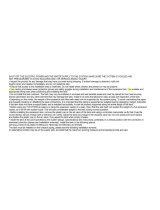5
PREFACE
ENGLISH
PREFACE
This installation manual is to present information and guide about understanding, installing,
and checking .
Your careful reading before installation is highly appreciated to make no mistake and to prevent
potential risks. The manual is divided into ten chapters. These chapters are classified according to
installation procedure. See the table below to get summarized information.
REMARK : ALL CONTENTS OF THIS MANUAL ARE SUBJECT TO CHANGE WITHOUT NOTICE.
TO GET THE LATEST INFORMATION, PLEASE VISIT LG ELECTRONICS WEB SITE.
Chapters Contents
Chapter 1
• Warning and Caution concerned with safety.
• This chapter is directly related with human safety. We strongly recommend reading this
chapter carefully.
Chapter 2
• Items Inside product Box
• Before starting installation, please make it sure that all parts are found inside the product
box.
Chapter 3
• Fundamental knowledge about
• Model identification, accessories information, cycle diagram, parts and dimensions, etc.
• This chapter is important to understand
Chapter 4
• Installation about the outdoor unit.
• Installation location, constraints on installation site, etc
Chapter 5
• Installation about the indoor unit.
• Installation location, constraints on installation site, etc
Chapter 6
• How to perform piping (for refrigerant) and wiring at the outdoor unit.
• Refrigerant pipe connection between the indoor unit and the outdoor unit.
• Electrical wiring at the outdoor unit.
Chapter 7
• How to perform piping (for water) and wiring at the indoor unit.
• Water pipe connection between the indoor unit and pre-built under floor water loop pipe.
• Electrical wiring at the indoor unit.
• System set-up and configuration.
• As many control parameters of is adjustable by control panel, deep
understanding about this chapter is required to secure the operation flexibility of
• For more detailed information, please read the separate operation manual to use control
panel and adjust control parameters.
Chapter 8
• Information about supported accessories
• Specification, Constraints, and wiring are described.
• Before purchasing accessories, please find supported specification to buy proper one.
Chapter 9
• Information about installation setting.
• Dip switch, service, installer setting etc.
Chapter 10
• Check points before starting operation are explained.
• Troubleshooting, maintenance, and error code list are presented to correct problems.





















